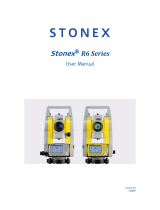
2. PRECAUTIONS
6
Other precautions
• If the SET is moved from a warm place to an extremely cold place, internal parts
may contract and make the keys difficult to operate. This is caused by cold air
trapped inside the hermetically sealed casing. If the keys do not depress, open
the battery cover to resume normal functionality. To prevent the keys from
becoming stiff, remove the connector caps before moving the SET to a cold
place.
• Never place the SET directly on the ground. Sand or dust may cause damage
to the screw holes or the centering screw on the base plate.
• Do not aim the telescope at the sun. Use the Solar filter to avoid causing internal
damage to the instrument when observing the sun.
C"31. OPTIONAL ACCESSORIES"
• Protect the SET from heavy shocks or vibration.
• Never carry the SET on the tripod to another site.
• Turn the power off before removing the battery.
• When placing the SET in its case, first remove its battery and place it in the case
in accordance with the layout plan.
Maintenance
• Always clean the instrument before returning it to the case. The lens requires
special care. First, dust it off with the lens brush to remove tiny particles. Then,
after providing a little condensation by breathing on the lens, wipe it with the
wiping cloth.
• If the display is dirty, carefully wipe it with a soft, dry cloth. To clean other parts
of the instrument or the carrying case, lightly moisten a soft cloth in a mild
detergent solution. Wring out excess water until the cloth is slightly damp, then
carefully wipe the surface of the unit. Do not use any organic solvents or
alkaline cleaning solutions.
• Store the SET in a dry room where the temperature remains fairly constant.
• Check the tripod for loose fit and loose screws.
• If any trouble is found on the rotatable portion, screws or optical parts (e.g.
lens), contact your SOKKIA agent.
• When the instrument is not used for a long time, check it at least once every 3
months.
C"27. CHECKS AND ADJUSTMENTS"
• When removing the SET from the carrying case, never pull it out by force. The
empty carrying case should be closed to protect it from moisture.
• Check the SET for proper adjustment periodically to maintain the instrument
accuracy.
X130R_02.FM 6 ページ 2003年10月14日 火曜日 午後8時32分























